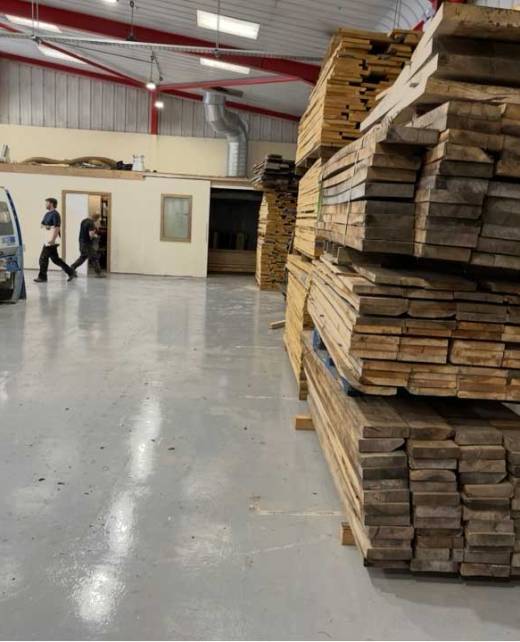
We will help you choose the right timber for your project
Wood Guide
Choosing the Ideal Wood for Any Project
Selecting the right wood is a crucial step in ensuring the strength, durability, and appearance of your finished work. Each type of timber has its own unique properties — from grain pattern and hardness to moisture resistance and cost. This guide will help you make an informed decision, whether you’re crafting fine furniture, framing a building, or undertaking a DIY project.
Understanding Wood Categories
Wood is generally divided into two main groups: hardwoods and softwoods.
| Category | Description | Common Uses | Example Species |
|---|---|---|---|
| Hardwoods | From broad-leaved deciduous trees. Dense, strong, and often richly grained. | Furniture, flooring, joinery, cabinetry. | Oak, Ash, Beech, Walnut, Maple. |
| Softwoods | From coniferous trees. Generally lighter and easier to work with. | Construction, cladding, framing, panelling. | Pine, Douglas Fir, Spruce, Larch, Cedar. |
Common Wood Species and Their Qualities
| Wood Type | Colour & Appearance | Strength & Density | Workability | Durability and uses |
|---|---|---|---|---|
| Oak | Light to medium brown, strong grain pattern | Very strong, dense | Moderate to hard machining | Excellent (resistant to wear) / used for flooring, furniture, framing, joinery |
| Ash | Pale cream with light brown streaks | Strong but slightly flexible | Good – machines and finishes well | Good / used for tool handles, furniture, interior joinery |
| Beech | Pale with fine, even grain | Hard and tough | Easy to turn and finish | Fair – not ideal outdoors / used for furniture, worktops, tool handles |
| Walnut | Rich dark brown with decorative grain | Strong and stable | Good, though can be brittle | Good / used for high-end furniture, interiors |
| Maple | Creamy white, smooth grain | Very hard and dense | Machines well | Excellent indoors / used for flooring, cabinetry |
| Pine | Pale yellow with visible knots | Moderate strength | Very easy to work | Fair / used for Interior joinery, shelving, framing |
| Douglas Fir | Reddish-brown, straight grain | Strong and stable | Good | Excellent outdoors when treated / used for structural beams, decking, frames |
| Larch | Reddish tone with visible grain | Hardest of the softwoods | Moderate | Naturally durable outdoors / cladding, fencing, exterior work |
| Cedar | Red-brown, aromatic, fine grain | Light but stable | Excellent | Highly durable outdoors / used for cladding, garden furniture, sheds |
Matching Wood to Your Project
| Project Type | Recommended Woods | Key Considerations |
|---|---|---|
| Furniture | Oak, Ash, Beech, Walnut | Choose hardwoods with good workability and attractive grain. |
| Flooring | Oak, Maple, Larch | Prioritise dense, durable woods that resist wear. |
| Joinery & Cabinetry | Oak, Pine, Ash | Balance aesthetics with ease of machining. |
| Outdoor Projects | Cedar, Larch, Douglas Fir, Accoya | Look for natural or treated durability. |
| Structural Work | Douglas Fir, Spruce, Larch | Ensure high strength and dimensional stability. |
| Decorative Finishes | Walnut, Cherry, Maple | Select based on colour, texture, and finish quality. |
Key Factors to Consider
- Strength & Stability – For load-bearing or structural uses, choose denser species.
- Durability – Outdoor applications require rot- and moisture-resistant woods.
- Workability – If you’ll be cutting, shaping, or joining by hand, select timbers that machine easily.
- Aesthetic Appeal – Consider grain pattern, colour, and how the wood takes stain or oil.
- Sustainability – Opt for FSC® or PEFC®-certified timber from responsibly managed forests.
- Budget – Hardwoods are generally more expensive; softwoods offer cost-effective alternatives.
Tips for Success
- Always buy seasoned or kiln-dried timber for indoor projects to prevent warping.
- For outdoor work, pressure-treated or naturally durable woods are essential.
- If unsure, consult your local timber supplier or machinist — they can recommend the best species and even cut or machine it to your specifications.
Summary
There’s no single ‘best’ wood — only the best wood for your purpose. By understanding each species’ qualities and matching them to your project’s needs, you’ll ensure your work is both beautiful and built to last.
Understanding Wood Categories
Wood is generally divided into two main groups: hardwoods and softwoods.
0
Projects
0
People
0
Years
0
Offices
Make your dreams come true by building the home you have always wanted!
What we offer
High-quality milling services and timber products, delivered with excellence, precision and skill
Peter Bowman
Samwill Owner






